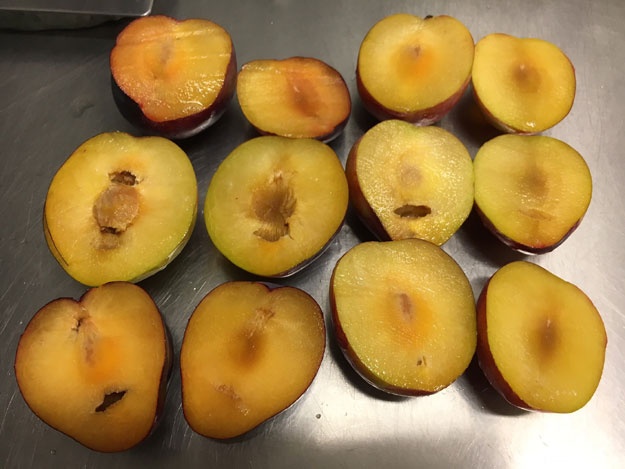I am sure you have seen hollow heart in watermelons and potatoes. My guess is hollow cavities found in plums is caused by the same growing condition, a sudden growth spurt brought on by heavy rains, heat or excessive fertilizer. This causes the fruit to grow rapidly, faster than the internal flesh, resulting in hollow spaces.

Unfortunately there is no external indication of which plums, when cut, will exhibit signs of having a hollow cavity. You must randomly cut the fruit, being sure to sample enough plums to accurately determine the percentage of plums with this defect.
The USDA has once again left us in the dark as to how to score this as a defect when found. The following is found in their Inspection Instructions: “Hollow cavities are to be scored under the general definition of damage and serious damage. Hollow cavities is considered characteristic for the Kelsey and Empress varieties and it is not to be scored as a defect. However, keep in mind if the hollow cavity in the Kelsey and Empress varieties is affected by internal discoloration it should be scored as such. See the section entitled “Internal Discoloration.”
Not much to go on. The USDA does not even classify this defect as a quality or as a condition defect. Based upon my experience I would classify the hollow cavities as a quality defect, as the defect happened in the orchard while growing and the hollow area will not get larger in size the longer the plum is held in storage, meaning it will not progress or become worse. But the USDA does state if internal discoloration is associated with the hollow cavity then the defect shall be scored as “Internal Discoloration,” scored as a condition defect, meaning the discoloration will progress; it will become darker in color and the affected area will increase.
And lastly, the USDA does not provide a scoring guideline for hollow cavities…..how much is too much. As a guide I would suggest the following: If the hollow cavity exceeds an area greater than 3/8 inch score as damage, against the 8% tolerance for quality defects, and if the hollow cavity exceeds an area greater than 5/8 inch score as serious damage, against the 4% tolerance for serious damage quality defects.
Looking at the image above there are three plums found with hollow cavities. All three would be scored as defects, damage by hollow cavities, with the middle left plum being scored as serious damage.

2 Comments on “Plums- Hollow Cavities”
Are you holding any classes in 2017?
Training classes are typically designed for companies and their employees. As an individual please contact The Southeast Produce Council for training classes held in collaboration with IPT.